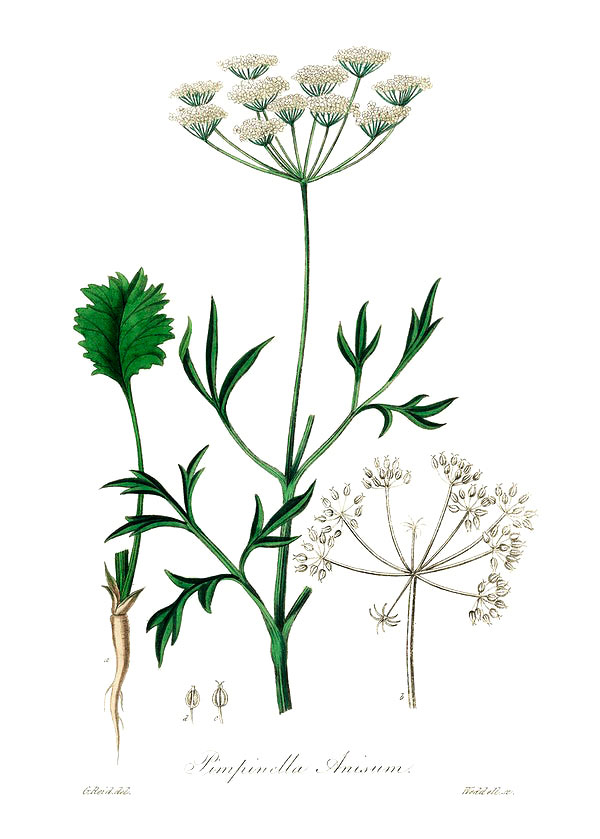Anise

Origin: Eastern Mediterranean and south-east Asia
Family: Apiaceae
Scientific Name: Pimpinella anisum L.
Folk Names: Anet, Aneys, Aniseed, Anise Burnet Saxifrage, Anix, Anny, Annyle, Sweet-cumin
Magical
Element: Air
Day: Thursday
Planet: Jupiter
Zodiac: Gemini
Deities: Hecate, Apollo, Hermes, Mercury
Parts used: Seeds
Magical Properties: Protection, purification, love, psychic skills, divination, vitality, banishing, exorcism, youth
Substitutions: Star anise, fennel
Lore
Anise was cultivated and used medicinally in Egypt for about 4,000 years.
It was also used by the ancient Greeks and Romans:
- In after-dinner cakes to aid digestion
- The Romans prized it so highly that the seeds were used to pay taxes
- Greek philosopher Theophrastus (~300 BCE), suggested that anise seeds by one’s bed at night gave sweet dreams.
- Romans bathed in fresh anise leaves before marriage to protect the union and ensure happiness. It was also added to wedding cakes to ensure a long, happy marriage, filled with children - this is believed to be the origin of the wedding cake.
Anise was mentioned in De Materia Medica (50-70CE), the first authoritative book on medicines. It was listed as being an antirheumetic.
Magical Uses
- Use a pillow of anise to keep away nightmares.
- Carry a sprig of anise to help you find happiness.
- Use anise to flavour wedding cakes to ensure continuing love.
- Make anise cookies to promote love and establishing relationships.
- Place aniseed in a purple drawstring bag and carry on you for protection.
- Add a handful of anise seeds and bay leaves for a good, general cleansing bath.
- As it’s used to treat arthritis, it can be used in magic to help provide motivation to get unstuck.
- For divine assistance making a difficult decision, burn an incense of equal parts aniseed and angelica root.
- Add a bit of anise oil to bath salts to attune yourself psychically before divining. This may also help with sleep, so try in the evening.
- Promote youthfulness by hanging sprigs of anise over your bed at night, or placing seeds in your shoes (a drop of diluted essential oil could also be used).
Aromatherapy
Part Used: Seeds
Extraction Method: Steam distillation
Flash Point: 94°C
Scent Type: Spicy
Perfume Note: Top
Scent Description: Spicy-sweet, liquorice-like scent
Active Constituents: Anethole (80–90%)
Aromatherapeutic Uses
Sedative/calming effect that helps with anxiety and nervousness. Can help with headaches and migraines.
Also strongly anti-fungal, repels mosquitoes, and is toxic to head lice.
Warnings:
- Avoid during pregnancy.
- Can cause skin irritation: use only in low dilutions.
- Sensitising: should be used in moderation, and not for more than 2 weeks consecutively.
- Do not confuse with anise hyssop (Agastache foeniculum), which can cause seizures
Medicinal
Medicinal Properties:
- Expectorant
- Carmative
- Spasmolytic
- Parasiticide
Medicinal Uses:
- Anise may increase iron absorption.
- Consume aniseed products after a meal to aid digestion.
- It can produce an estrogen-like effect on the body, and thus may be used to stimulate production of breast milk.
- Anise is helpful for coughs and easing congestion. It can be added to cough syrups or lozenges, or taken as a tea or tincture (see below).
Aniseed Tea: Infuse 1tsp of aniseeds per cup of water; take up to 1.5 cups per day to help with coughs/congestion.
Aniseed Tincture: Add 60g of aniseeds and some lemon peel to 1L of brandy and let sit for at least two weeks; take 1tsp as needed.
Warnings/Interactions:
- Can be toxic in large quantities.
- Be aware of taking anise if also taking iron supplements.
- People with allergies to any other members of the Apiaceae family are likely to be sensitive to anise.
- Anise can have some of the same effects in the body as estrogen, which may interact with hormonal medications (eg birth control), or affect cancers/illnesses which are impacted by hormone levels.
Practical
Some dogs react to anise similarly to cats with catnip (just be cautious of the amount consumed, as it can be toxic in large quantities).
Culinary
The entire plant is edible: Flowers and leave can be used in salads, and the stem and roots can be used to add flavour to soups and stews.
Aniseed is frequently used in cooking, especially sweets, desserts, and digestives.
It is also used to flavour several digestifs and liqueurs, including anisette, arak, French absinthe, ouzo, raki, and sambuca.
Beauty
Anise is a popular scent component for perfumes and beauty products.
Botanical
Anise is an erect herb which resembles members of the carrot family, and has a licorice-like scent.
Type: Annual herb
Plant size: 30-45cm
Leaves: Feathery, finely-divided upper leaves, and broader, toothed lower leaves
Flowers: Umbels of delicate white/yellow star-like flowers produced late summer
Fruit: Oblong and 2-5mm long, called ‘aniseed’
Etymology: ‘Anise’ comes from the Old French version of the latin word anisum, or Greek, anison, referring to dill.
In the Garden
Type: Annual
Sow: Late spring
Light: Bright light
Soil: Rich, sandy/well-drained
Companion Planting: Grows well with coriander; should not be grown with carrot.
Tips:
- Likes slightly alkaline soil.
- Does not like being transplanted, but will grow well in a pot.
- Takes 120 days to produce fully-ripened seed heads.
- Anise seeds need a hot summer to properly ripen.
- Pick fresh leaves as required; harvest flowers as they open, and seeds once they are grey-green at the tips.
